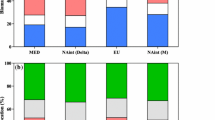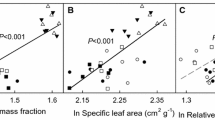Abstract
To explore the traits contributing to invasion success of Eupatorium adenophorum, a noxious invasive perennial forb throughout the subtropics in Asia, Oceania, Africa, and USA, we compared the differences in ecophysiology and phenology between the invader and native E. japonicum under eight treatment combinations of two irradiances and four nitrogen additions in a two-year shadehouse experiment. The invader had significantly higher mass-based light-saturated photosynthetic rate (P max) than its native congener in all treatments, contributing to higher photosynthetic nitrogen-, phosphorus-, and energy-use efficiencies. The higher P max of the invader was associated with its higher nitrogen concentrations in the photosynthetic apparatus, which resulted from higher leaf nitrogen allocation to photosynthesis. The invader had higher specific leaf area and stomatal conductance at most of the treatments, also contributing to its higher P max. The invader was not constrained by the negative correlation between leaf lifespan and specific leaf area or P max. Leaf lifespan and total leaf area of the invader were greater than those of the native. From November to March the native congener was leafless, whereas the invader maintained a large area of leaves with relatively high P max. Biomass accumulated in these months accounted for more than 40 % of the total biomass of the invader. Our results indicate that both the ability to capture and utilize resources efficiently and the ability to use resources when they are unavailable to natives contribute to invasion success of E. adenophorum and emphasize the importance of exploring multiple, non-mutually exclusive mechanisms for invasions.



Similar content being viewed by others
References
Baruch Z, Goldstein G (1999) Leaf construction cost, nutrient concentration, and net CO2 assimilation of native and invasive species in Hawaii. Oecologia 121:183–192
Catt JW, Millard P (1988) The measurement of ribulose 1,5-bisphosphate carboxylase oxygenase concentration in the leaves of potato plants by enzyme linked immunosorbtion assays. J Exp Bot 39:157–164
Daehler CC (2003) Performance comparisons of co-occurring native and alien invasive plants: implications for conservation and restoration. Annu Rev Ecol Evol Syst 34:183–211
Davis MA, Grime JP, Thompson K (2000) Fluctuating resources in plant communities: a general theory of invasibility. J Ecol 88:528–534
Dawson W, Fischer M, van Kleunen M (2011) The maximum relative growth rate of common UK plant species is positively associated with their global invasiveness. Global Ecol Biogeogr 20:299–306
Feng Y-L (2008) Nitrogen allocation and partitioning in invasive and native Eupatorium species. Physiol Plant 132:350–358
Feng Y-L, Auge H, Ebeling SK (2007) Invasive Buddleja davidii allocates more nitrogen to its photosynthetic machinery than five native woody species. Oecologia 153:501–510
Feng Y-L, Lei Y-B, Wang R-F, Callaway RM, Valiente-Banuet A, Inderjit, Li Y-P, Zheng Y-L (2009) Evolutionary tradeoffs for nitrogen allocation to photosynthesis versus cell walls in an invasive plant. Proc Natl Acad Sci USA 106:1853–1856
Feng Y-L, Li Y-P, Wang R-F, Callaway RM, Valiente-Banuet A, Inderjit (2011) A quicker return energy-use strategy by populations of a subtropical invader in the non-native range: a potential mechanism for the evolution of increased competitive ability. J Ecol 99:1116–1123
Fridley JD (2012) Extended leaf phenology and the autumn niche in deciduous forest invasions. Nature 485:359–364
Funk JL, Vitousek PM (2007) Resource-use efficiency and plant invasion in low-resource systems. Nature 446:1079–1081
Goodger JQD, Gleadow RM, Woodrow IE (2006) Growth cost and ontogenetic expression patterns of defence in cyanogenic Eucalyptus spp. Trees 20:757–765
Han W, Fang J, Guo D, Zhang Y (2005) Leaf nitrogen and phosphorus stoichiometry across 753 terrestrial plant species in China. New Phytol 168:377–385
Harrison MT, Edwards EJ, Farquhar GD, Nicotra AB, Evans JR (2009) Nitrogen in cell walls of sclerophyllous leaves accounts for little of the variation in photosynthetic nitrogen-use efficiency. Plant Cell Environ 32:259–270
Hikosaka K, Shigeno A (2009) The role of Rubisco and cell walls in the interspecific variation in photosynthetic capacity. Oecologia 160:443–451
Kurokawa H, Nakashizuka T (2008) Leaf herbivory and decomposability in a Malaysian tropical rain forest. Ecology 89:2645–2656
Kurokawa H, Peltzer DA, Wardle DA (2010) Plant traits, leaf palatability and litter decomposability for co-occurring woody species differing in invasion status and nitrogen fixation ability. Funct Ecol 24:513–523
Lamarque LJ, Delzon S, Lortie CJ (2011) Tree invasions: a comparative test of the dominant hypotheses and functional traits. Biol Invasions 13:1969–1989
Lambers H, Poorter H (1992) Inherent variation in growth-rate between higher-plants: a search for physiological causes and ecological consequences. Adv Ecol Res 23:187–261
Lei Y-B, Wang W-B, Feng Y-L, Zheng Y-L, Gong H-D (2012) Synergistic interactions of CO2 enrichment and nitrogen deposition promote growth and ecophysiological advantages of invading Eupatorium adenophorum in Southwest China. Planta 236:1205–1213
Lichtenthaler HK, Wellburn AR (1983) Determination of total carotenoids and chlorophyll a and b of leaf extracts in different solvents. Biochem Soc Trans 603:591–592
Moran MD (2003) Arguments for rejecting the sequential Bonferroni in ecological studies. Oikos 100:403–405
Mozdzer TJ, Zieman JC (2010) Ecophysiological differences between genetic lineages facilitate the invasion of non-native Phragmites australis in North American Atlantic coast wetlands. J Ecol 98:451–458
Nagel JM, Griffin KL (2001) Construction cost and invasive potential: comparing Lythrum salicaria (Lythraceae) with co-occurring native species along pond banks. Am J Bot 88:2252–2258
Onoda Y, Hikosaka K, Hirose T (2004) Allocation of nitrogen to cell walls decreases photosynthetic nitrogen-use efficiency. Funct Ecol 18:419–425
Osunkoya OO, Bayliss D, Panetta FD, Vivian-Smith G (2010) Leaf trait co-ordination in relation to construction cost, carbon gain and resource-use efficiency in exotic invasive and native woody vine species. Ann Bot 106:371–380
Pimentel D, McNair S, Janecka J, Wightman J, Simmonds C, O’Connell C, Wong E, Russel L, Zern J, Aquino T, Tsomondo T (2001) Economic and environmental threats of alien plant, animal, and microbe invasions. Agric Ecosyst Environ 84:1–20
Pyšek P, Richardson DM (2007) Traits associated with invasiveness in alien plants: where do we stand?. Springer, Berlin, Heidelberg
Qing H, Cai Y, Xiao Y, Yao Y-H, An S-Q (2012) Leaf nitrogen partition between photosynthesis and structural defense in invasive and native tall form Spartina alterniflora populations: effects of nitrogen treatments. Biol Invasions 14:2039–2048
Reich PB, Walters MB, Ellsworth DS (1997) From tropics to tundra: global convergence in plant functioning. Proc Natl Acad Sci USA 94:13730–13734
Schlesinger WH, Chabot BF (1977) The use of water and minerals by evergreen and deciduous shrubs in Okefenokee Swamp. Bot Gaz 138:490–497
Song L-Y, Li C-H, Peng S-L (2009) Elevated CO2 increases energy-use efficiency of invasive Wedelia trilobata over its indigenous congener. Biol Invasions 12:1221–1230
Taiz L, Zeiger E (1991) Plant physiology. The Benjamin/Cummings Publishing Co., Inc., Redwood City, CA
Takashima T, Hikosaka K, Hirose T (2004) Photosynthesis or persistence: nitrogen allocation in leaves of evergreen and deciduous Quercus species. Plant Cell Environ 27:1047–1054
Wang M-L, Feng Y-L (2005) Effects of soil nitrogen levels on morphology, biomass allocation and photosynthesis in Ageratina adenophora and Chromoleana odorata. Acta Phytoecol Sin 29:697–705
Williams K, Percival F, Merino J, Mooney HA (1987) Estimation of tissue construction cost from heat of combustion and organic nitrogen-content. Plant Cell Environ 10:725–734
Wright IJ, Cannon K (2001) Relationships between leaf lifespan and structural defences in a low-nutrient, sclerophyll flora. Funct Ecol 15:351–359
Xu H, Ding H, Li M, Qiang S, Guo J, Han Z, Huang Z, Sun H, He S, Wu H (2006) The distribution and economic losses of alien species invasion to China. Biol Invasions 8:1495–1500
Xu C-Y, Griffin KL, Schuster WS (2007) Leaf phenology and seasonal variation of photosynthesis of invasive Berberis thunbergii (Japanese barberry) and two co-occurring native understory shrubs in a northeastern United States deciduous forest. Oecologia 154:11–21
Zhao X-J, Liu W-Y, Zhou M, Ma W-Z (2009) Comparison of growth and reproduction characters among different populations of Eupatorium adenophorum in Yunnan. Acta Bot Boreal-Occid Sin 29:1252–1258
Zheng Y-L, Feng Y-L, Liu W-X, Liao Z-Y (2009) Growth, biomass allocation, morphology, and photosynthesis of invasive Eupatorium adenophorum and its native congeners grown at four irradiances. Plant Ecol 203:263–271
Zheng Y-L, Feng Y-L, Wang R-F, Shi X-D, Lei Y-B, Han L-H (2012) Invasive Eupatorium adenophorum suffers lower enemy impact on carbon assimilation than native congeners. Ecol Res 27:867–872
Acknowledgments
This study was supported by the Project of the National Natural Science Foundation of China (31270582, 30830027, and 30670394).
Author information
Authors and Affiliations
Corresponding author
Additional information
Wei-Bin Wang and Rui-Fang Wang contributed equally to this paper.
Electronic supplementary material
Below is the link to the electronic supplementary material.
Rights and permissions
About this article
Cite this article
Wang, WB., Wang, RF., Lei, YB. et al. High resource capture and use efficiency and prolonged growth season contribute to invasiveness of Eupatorium adenophorum . Plant Ecol 214, 857–868 (2013). https://doi.org/10.1007/s11258-013-0214-x
Received:
Accepted:
Published:
Issue Date:
DOI: https://doi.org/10.1007/s11258-013-0214-x




